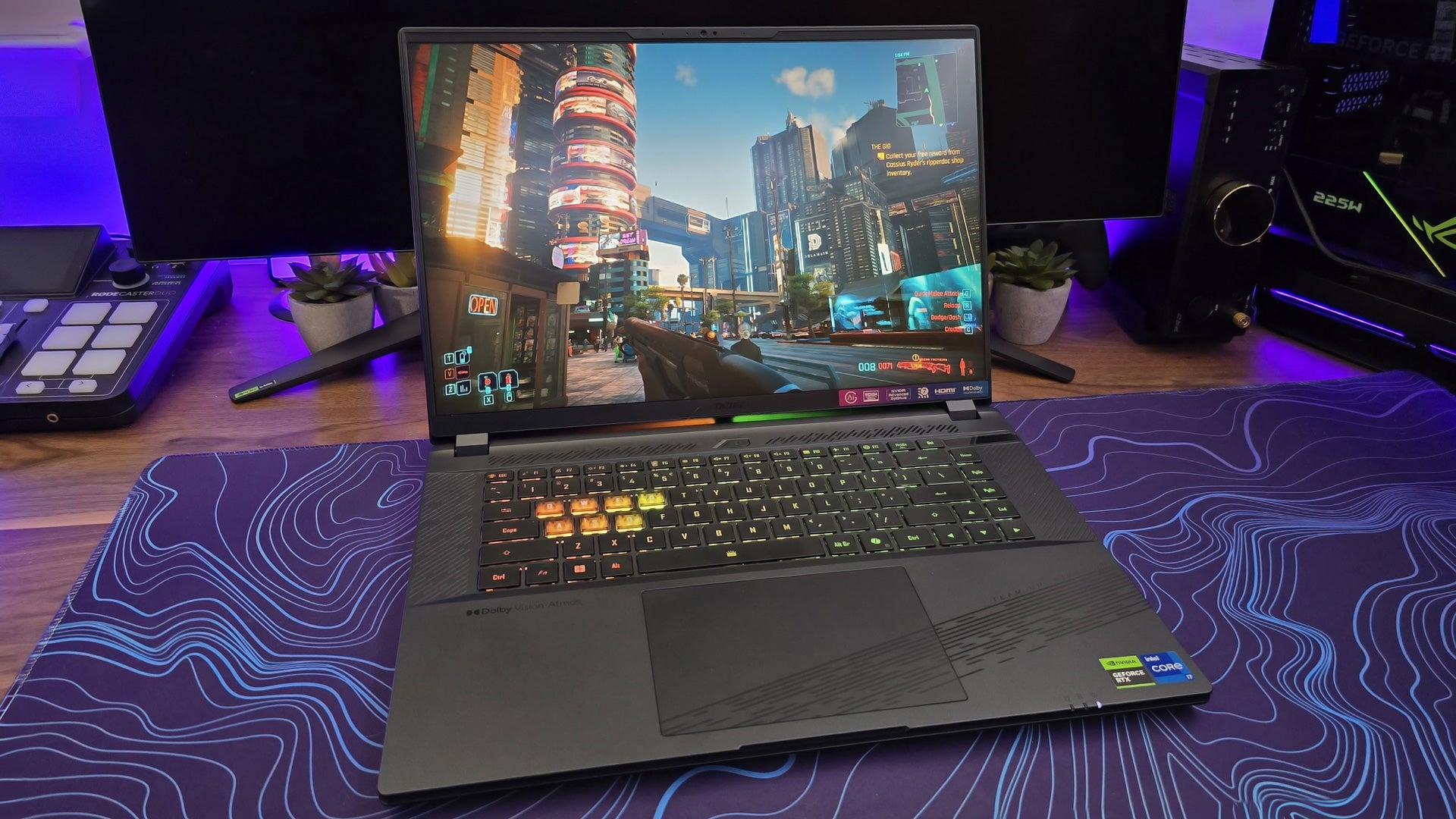The Gigabyte Aorus 16X ASG is out to take a bite of the midrange gaming laptop apple. With a price that extends from $1,349 to $1,799 depending on your configuration, it makes big promises on performance and cooling. Packing a high-performance 14th-gen Intel processor, an RTX 4060 or 4070 graphics card, and a high-res, high refresh rate, Dolby Vision screen, it’s specced to deliver. And for the most part, it does, but be prepared to grab a gaming headset to contend with its fans.
Gigabyte Aorus 16X ASG (2024) – Design and Features
The Aorus 16X is a 16-inch laptop aiming at the mid-range of the gaming market. It’s stylish, well-built, and offers competitive performance. Just as the laptop itself targets the midrange of the price and performance bracket, the middle configuration seems to be the best value and offers good bang for the buck.
Our unit came with the following specs:
It’s a fairly powerful combination of hardware. Its Intel processor features 16 cores and 24 threads evenly split between performance cores and efficiency cores. It has a high clock speed that boosts up to 5.2GHz, which most games benefit from even more than core count. Paired with its 32GB of memory, it’s capable of everything from multitasking lots of Chrome tabs to editing videos in Adobe Premiere Pro and After Effects.
For gaming, the most important component is the graphics card. The 16X ASG features an RTX 4070 in this configuration, which is more than capable of running games at its native resolution at high settings. You can bump things up further by stepping resolution down a notch. It’s not Nvidia’s most powerful mobile graphics card, or the most entry level, and is well suited to this level of laptop. You’ll need to make some sacrifices in graphics at times, but for the most part, it will let you enjoy a full-fat gaming experience with all of the eye-candy that entails.
There are several variants of the laptop available. You can pick it up with the Intel Core i7-14650HX we tested or spend a couple hundred more for the higher-specced Core i9-14900HX. Those options are also available with either an RTX 4060 or RTX 4070. Depending on where you purchase from, you can also find it with either 16GB or 32GB of memory and up to 2TB of storage. If you’re a tinkerer, each model is upgradeable and supports up to 64GB of memory and up to 4TB of storage. There’s even a second M.2 slot so you won’t have to go through the hassle of reinstalling Windows.

No matter which model you choose, it comes with a quality 2560 x 1600 display, equivalent to 1440p in its more square 16:10 aspect ratio. It looks plenty crisp at this screen size and is quite bright at 508 nits as measured with my colorimeter. Its color coverage is also very good with 100% sRGB coverage and 79% of the DCI-P3 color space. It did need some calibration to dial in some slightly oversaturated colors, but hobbyists don’t need to be concerned about their photos and videos looking skewed.
It’s also fast, running at a maximum refresh rate of 165Hz. I find this a bit surprising as last year’s Aorus 16 featured a 240Hz refresh rate. Having never tested that laptop, I can’t say for sure, but I’ve seen other reviewers that have and praised its improvement in other areas. It also supports Nvidia G-Sync to prevent screen tearing and ensure a smooth gameplay experience.
Interestingly, the display supports Dolby Vision. Unlike most HDR experiences, Dolby Vision allows moviemakers to encode brightness and contrast per scene instead of for the whole film. Since the display only hits 500 nits and not the 1,000 nits we usually associate with HDR, it can’t really offer true high dynamic range to make the most of this. It does improve upon a non-Dolby screen with its contrast, though, so there is some benefit and it’s a good inclusion overall.
The laptop comes with 1TB of NVMe storage by default, but the most expensive version comes with 2TB. It’s fast storage, perfect for minimizing load times.
The build quality is solid. The lid is made of aluminum while the rest of the chassis is plastic. I would have preferred to see more alloy included at this price but it feels solid with no worrying flex, even on the keyboard. The hinge doesn’t creak and stays in place well without wobbling overmuch while typing.

It has a definite “gamer” sense of style but isn’t overdone. The whole computer is an understated gunmetal gray, with a blacked-out Aorus falcon logo centered on the lid. There’s an RGB strip on the back that projects “AORUS” onto the desk behind it, but can be turned off if it’s not your thing. The keyboard is RGB-backlit and can be customized across three zones. The WASD and QER keys are translucent, which looks pretty cool and really shines in the dark.
There’s a good amount of detail work on the deck with angular stripes on either side of the keyboard, making up the speaker grilles, and stenciled onto the palmrest and even the touchpad. Flip it over and there’s a similar design to the bottom venting. It looks like a gaming laptop, but simply turning off the RGB goes a long way to dialing that back if you’d like to.

The keyboard and touchpad are both pretty good but won’t blow your socks off. Its chiclet keys have a generous 1.7mm travel distance with a satisfying tactility and don’t feel overly mushy. The touchpad is large and responsive – I had to be careful as it was very sensitive to gestures with any kind of multitouch. The buttons are integrated into the bottom corners, though clicking higher up on the pad sometimes didn’t register, so you’ll need to make sure you’re pressing on its lower quarter.

It’s generous with its connectivity but I wish it had moved more of it to the back and out of the way. All of its ports are located on the sides, including its thick power adapter which refused to plug in all the way. It didn’t interfere with performance at all, but having that thick cable coming out of the left side can get in the way if you’re a lefty or have an open textbook at its side. There is a Type-A and Type-C port on both sides each, as well as an HDMI 2.1 jack and a gigabit ethernet port on the left, in addition to the power cable. On the right, you’ll find the microSD card reader and the combo audio jack for a wired headset.

Wireless connectivity is also very good and supports the latest standards. It sports WiFi 7 which allows for the highest speed connections currently available and Bluetooth 5.4 for improved efficiency and reliability. WiFi 7 is still very new – so much so that, as of this writing, you won’t find it in many places. That will come in time, however, so it’s good to see that 16X ASG will be ready when it does.
It comes with a decent webcam that can easily suffice for online meetings and even a facecam for streaming. It records at 1080p with 30 fps, which one-ups most of the 720p webcams you’ll find in this range. It’s more crisp than those but still struggles with background lighting. As you can see in the picture below, the strip light is blown out and the rest of the picture is darker than it should be. Not bad, and certainly usable, but there’s still room for growth in next year’s model. The camera can also be used for Windows Hello and worked very reliably to login to Windows.
Gigabyte plays up the speakers in the 16X and how they feature Dolby Atmos. To my ear, they sounded like pretty standard laptop speakers. You can use them for basic listening but for any real gaming, you’ll want to use a pair of headphones and enjoy Atmos that way. The sound lacks bass, as expected, and distorts at higher volumes. They’re far from the worst I’ve heard, but my Asus ROG Strix G15 from 2021 was far superior in every way.
The system also sports a giant 99wHr battery. It’s the highest capacity battery you can find in a gaming laptop and provides the system with respectable battery life. Though, like always, if you’re playing games you should plug in. Not only will it mean you don’t need to worry about the battery dying but it also allows the hardware to run at its full performance.
Before moving on, we need to address the elephant in the room. Gigabyte has branded this Aorus 16X as an “AI PC.” Its product page mentions AI no less than two dozen times. It is not, at least in the sense of its processor and how that term is being used to specifically refer to AI-enabled CPUs. There are no Neural Processing Units (NPUs) on the Intel Core i7-14650HX. That is currently reserved for Intel’s Core Ultra series and AMD’s Ryzen AI CPUs. Here, all of its AI capabilities come from the graphics card, which is true of every laptop using an Nvidia RTX graphics card.
In short, though Gigabyte tries to leverage the term for marketing, this is as much an “AI PC” as a huge swath of other gaming laptops. It does have AI processing capabilities, and Gigabyte includes some AI options in its Control Center Software, but don’t be tricked into thinking this is all that different from a normal gaming laptop at its core.
Gigabyte Aorus 16X ASG (2024) – Software
The 16X uses Gigabyte Control Center for its configuration duties. As we saw with the G6X 9KG, it’s a fairly utilitarian piece of software that also manages to be confusing to use due to poor explanations of its features.

All of the basics you would expect are here. You can set the performance mode, fan profile, and get a quick eye on current system specs like CPU and GPU temperatures. You can control its lighting with a handful of presets or choose static colors for the keyboard and tail light. Unlike the cheaper G6X, you can’t assign macros – something the product page specifically calls out. Maybe it’s available as a separate download, but using a fully updated version of the software that came with the laptop, this functionality is nowhere to be found.
The problem is that it just doesn’t offer a whole lot. The main tab, General, is a home base for choosing your performance mode and fan profile. To the right of these settings are just over a dozen toggles for things like WiFi, power and charge modes, and two toggles to let the system dial back the refresh rate and RGB to save power. There are also a handful of toggles for things like opening the Nvidia Control Panel or Dolby app, and adjusting the brightness and volume. It’s all well and good but a lot of these things feel like they’re there to fill space.

Gigabyte has also made a point to force AI into the app, but it’s unclear what most of it means or actually does. The performance modes all live in the “AI Nexus,” and there are the usual Power Saving, Balanced, and Performance modes, as well as an AI Auto Gear option that scales up power and performance based on demand. Does AI impact Performance or Balanced mode? If not, why are they in the AI section?
If you click in to find out more, the only things you’ll find are toggles for the iGPU and the actual graphics card. Below that is a list of different applications with a tooltip to “please stop application to enter CPU power saving” and a stop and refresh button – except the applications and buttons aren’t clickable. AI Auto Gear, it seems, is just Gigabyte’s take on Advanced Optimus and switches between the dGPU and iGPU to save power. If that’s AI, then we’ve had it for a number of years.

The software also includes a baked-in version of Stable Diffusion for AI image generation. It’s a neat app, but including it here just feels like the company saying, “see guys, this really is an AI laptop!” But hey, it’s fun to play with… until you realize that Microsoft Copilot does a far superior job of image generation.
Overall, the Gigabyte Control Center is functional and does the basics well enough, but it falls short when compared to the likes of Asus Armoury Crate or MSI Center.
Gigabyte Aorus 16X ASG (2024) – Performance
After spending a week with the Gigabyte 16X ASG, I’m left mostly impressed with what it has to offer. At $1,600 for our model, it’s on the expensive end but offers reliably good gaming performance and has the hardware chops for just about anything else you’d like to do throughout the day. Its battery life can extend through most of a day (though you might want to keep a charger on standby) and, when you’re not gaming, is quiet and cool. When you do load up a game, well, that’s another story.
We test our systems using a mix of synthetic and real world benchmarks for objective comparison. We then live with the laptop for a week or two to get a good idea of how it performs in a wider context. All games are set to Ultra settings or are manually set to maximum. Ray tracing and DLSS are enabled in balanced mode where available with separate figures for frame generation.

The Aorus 16X ASG did very well in our benchmarks. The faster processor allowed it to score much higher than last year’s Aorus 15. Note that the Hitman results on that model and the Lenovo Legion Pro i7 appear to be without DLSS on the first run. Compared to the Asus and Lenovo, which have an RTX 4060 and 4080, the results shake out exactly as you would expect they would with the 16X falling squarely in the middle.
The results are good and show that the laptop is able to maintain playable frame rates at 1600p. Only Total War: Warhammer 3 and Cyberpunk 2077 fell short of 60 fps but both are easily pushed beyond that point by turning graphics settings down slightly.

Since Gigabyte markets the laptop on its AI capabilities, we decided to run it through Procyon, our current AI benchmarking tool. Since laptops with dedicated NPUs are still so new, the only other laptop we had to compare it against was the Samsung Galaxy Book 4 running a new ARM chip from Qualcomm. To Gigabyte’s credit, the RTX 4070 is no slouch in AI performance. Its tensor cores are very capable and it significantly outpaced the NPU on the Galaxy Book 4.
While I disagree with the direction of the marketing and how it seems to “me too” the AI craze, this serves as a good example that “AI PCs” have actually been among us for a long time. How they’re leveraged is evolving, and while the term as it is being used today doesn’t call to mind your average Nvidia-loaded gaming laptop, it’s true nonetheless.
This comparison also goes to show what investing in a great GPU will get you compared to a processor with an NPU. Though integrated graphics are improving with every generation, for gaming, the graphics card still rules the roost.
In wider testing, it performed equally well. Baldur’s Gate 3 remained well above 60 fps throughout my progress in Act 3. Battlefield 2042 well exceeded it and played exceptionally smoothly. The same was true in God of War, which I can’t seem to stay away from, despite beating it long ago.

Playing at 1200p is a viable option to bump frame rates well above what’s possible at 1600p, but you might not want to. It didn’t bother me, but the uneven scaling ratio causes more blurring than dropping from 4K to 1080p does. Games hardly look bad, but the subtle softness from dropping resolution and that uneven scaling factor compounds in a way that is immediately noticeable.
Every game looked good on the screen too. Its IPS display isn’t an OLED with inky blacks, but colors were vivid and there wasn’t any backlight bleed to take away from its contrast. With G-Sync enabled, even the games that struggled hitting 60 fps still felt smooth to play.
The keyboard worked perfectly fine but did get quite warm under my fingers. Even with the fans running full tilt, the heat bleed was inescapable if I was gaming for any more than twenty minutes.

Speaking of the fans, prepare your headphones now because those fans are loud. Gaming laptops have to balance temperatures, noise, and performance, and usually sacrifice one to deliver on the others. Here, fan noise was clearly the sacrifice. It’s not a laptop you can use to play games on the couch without bothering the person watching TV next to you, nor would you want to use it in a library between classes. Its loud woosh is bothersome. Thankfully, it’s only a problem when the laptop is under load. For normal work, it’s mostly silent.
Battery life is good but you’ll want to bring a charger just in case. In our PCMark 10 Modern Office battery test, it was able to last seven hours and 46 minutes. This is about accurate to normal mixed task daily use in my testing, so you can confidently make it through most of a normal work day. If you plan on gaming, also plan on plugging in as it won’t last much more than an hour or two depending on what you’re playing.





